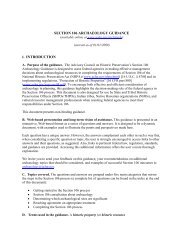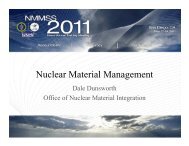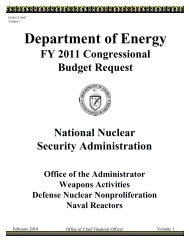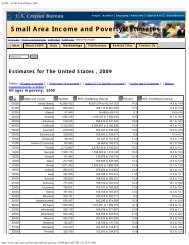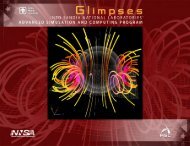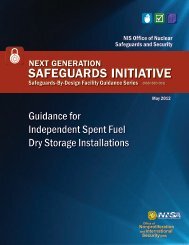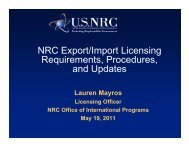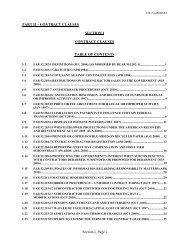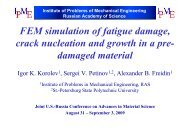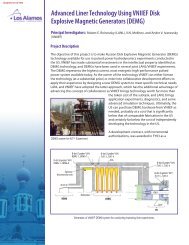ASC Code Strategy - National Nuclear Security Administration
ASC Code Strategy - National Nuclear Security Administration
ASC Code Strategy - National Nuclear Security Administration
You also want an ePaper? Increase the reach of your titles
YUMPU automatically turns print PDFs into web optimized ePapers that Google loves.
5.0 Summary and Impact<br />
This document has detailed the background, goals, and new strategies for the Integrated <strong>Code</strong>s program within <strong>ASC</strong>.<br />
We have described the current objectives, the current program state, and the existing and future challenges. This is<br />
summarized through a risk assessment that identifies important issues for the program, and motivates the development<br />
of this strategy. We have described in detail the new strategy, including the establishment of a national simulation<br />
portfolio, efforts to advance algorithms and codes to enable predictive simulation and QMU, and efforts to broaden<br />
the program’s impact in the national security arena. Finally, we have examined the risks associated with adopting these<br />
strategies and provided additional recommendations to mitigate those risks. A high-level description and impact of the<br />
current strategy on the program is given in Table 4.<br />
Table 4. Impact of the <strong>Code</strong> <strong>Strategy</strong> on Future <strong>ASC</strong> Program<br />
Focus Areas Current State Strategies Future State<br />
Integrated<br />
Simulation<br />
Capabilities<br />
(Application<br />
<strong>Code</strong>s)<br />
• 14 modern + numerous<br />
legacy codes across 6<br />
broad application areas<br />
• Core physics simulation<br />
competencies<br />
established<br />
Establish the<br />
<strong>National</strong> Simulation<br />
Portfolio for<br />
Stockpile<br />
Certification<br />
• 7 modern national<br />
capabilities<br />
• End legacy development<br />
• Core competencies<br />
sustained<br />
Computational<br />
Science<br />
• Tera scale computational<br />
science established (MPI<br />
programming model)<br />
• Basic capabilities<br />
for uncertainty<br />
quantification<br />
Advance<br />
computational<br />
algorithms to<br />
enable predictive<br />
simulation and QMU<br />
• Algorithms &<br />
programming models<br />
supporting predictive<br />
simulation at petaFLOP<br />
and exaFLOP scales<br />
• Advanced capabilities for<br />
uncertainty quantification<br />
and QMU studies<br />
Scope of<br />
Applications<br />
• <strong>ASC</strong> simulation<br />
capabilities focused<br />
on certification for tail<br />
numbers<br />
Broaden the impact<br />
of <strong>ASC</strong> simulation<br />
capabilities in<br />
national security<br />
• Capabilities for broader<br />
national security<br />
applications, including<br />
NNSA nuclear security<br />
and non-proliferation<br />
missions<br />
The implementation targets related to the strategy are addressed in Appendix A. We have separated the strategy<br />
content and its implementation in order to keep the main document focused on the goals, strategies, and ideas, and<br />
to ensure that the ideas behind the strategy remain relevant in the event that the implementation plan is substantially<br />
revised in response to budget and schedule constraints in the coming years.<br />
This strategy represents the ideas and efforts of the tri-lab integrated codes leads and managers, and the <strong>ASC</strong> program<br />
managers at NNSA. We believe the strategy developed herein will help the program to sustain its capabilities and<br />
meet future challenges, and to operate in a focused and interdependent manner for the benefit of the nuclear weapons<br />
complex. Adopting this strategy will mark a significant shift in the operational culture of the codes program, dating<br />
from before the inception of the <strong>ASC</strong>I Program. It is expected that such change will pose difficulties and require<br />
commitment from all organizations to succeed, but that the program and the laboratories see the necessity for change<br />
and will work together to make the program a continued success.<br />
19



